Organizational Change Management of Uber: Challenges and Solutions
VerifiedAdded on 2020/03/23
|8
|1618
|77
Report
AI Summary
This report provides an in-depth analysis of organizational change management within Uber, focusing on incorporating new security systems and addressing potential obstacles. The report begins with an executive summary and table of contents and then delves into the impact of these changes on both the organization and its customers. It identifies potential obstacles, such as financial instability due to high implementation costs, driver-related security concerns, and resistance from competitors and the public. The report employs the McKinsey 7-S framework to propose strategic solutions, including enhanced budgeting, advanced security measures like facial recognition, and thorough driver verification processes. The report concludes by emphasizing the importance of shared values in successful change management and provides a comprehensive list of references.
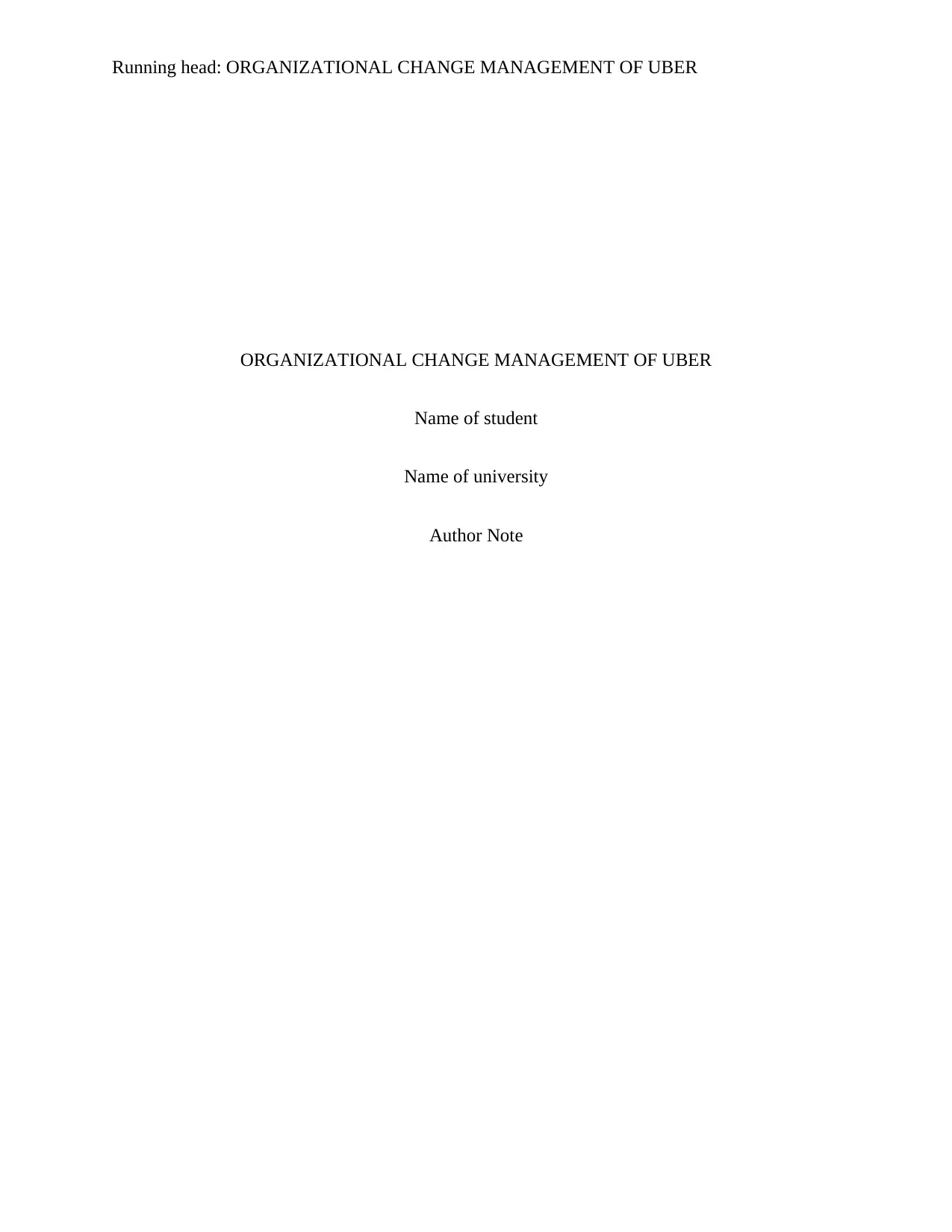
Running head: ORGANIZATIONAL CHANGE MANAGEMENT OF UBER
ORGANIZATIONAL CHANGE MANAGEMENT OF UBER
Name of student
Name of university
Author Note
ORGANIZATIONAL CHANGE MANAGEMENT OF UBER
Name of student
Name of university
Author Note
Paraphrase This Document
Need a fresh take? Get an instant paraphrase of this document with our AI Paraphraser
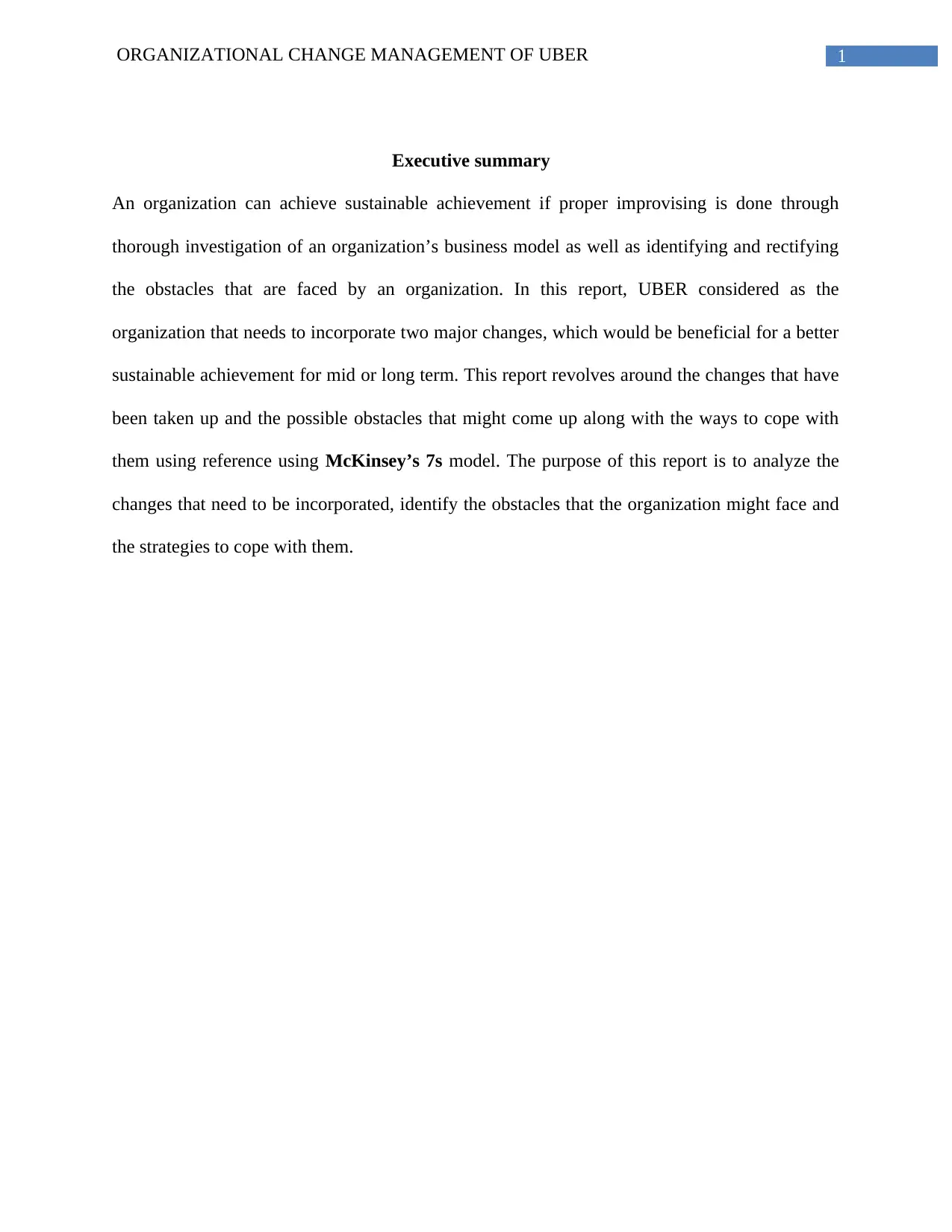
1ORGANIZATIONAL CHANGE MANAGEMENT OF UBER
Executive summary
An organization can achieve sustainable achievement if proper improvising is done through
thorough investigation of an organization’s business model as well as identifying and rectifying
the obstacles that are faced by an organization. In this report, UBER considered as the
organization that needs to incorporate two major changes, which would be beneficial for a better
sustainable achievement for mid or long term. This report revolves around the changes that have
been taken up and the possible obstacles that might come up along with the ways to cope with
them using reference using McKinsey’s 7s model. The purpose of this report is to analyze the
changes that need to be incorporated, identify the obstacles that the organization might face and
the strategies to cope with them.
Executive summary
An organization can achieve sustainable achievement if proper improvising is done through
thorough investigation of an organization’s business model as well as identifying and rectifying
the obstacles that are faced by an organization. In this report, UBER considered as the
organization that needs to incorporate two major changes, which would be beneficial for a better
sustainable achievement for mid or long term. This report revolves around the changes that have
been taken up and the possible obstacles that might come up along with the ways to cope with
them using reference using McKinsey’s 7s model. The purpose of this report is to analyze the
changes that need to be incorporated, identify the obstacles that the organization might face and
the strategies to cope with them.
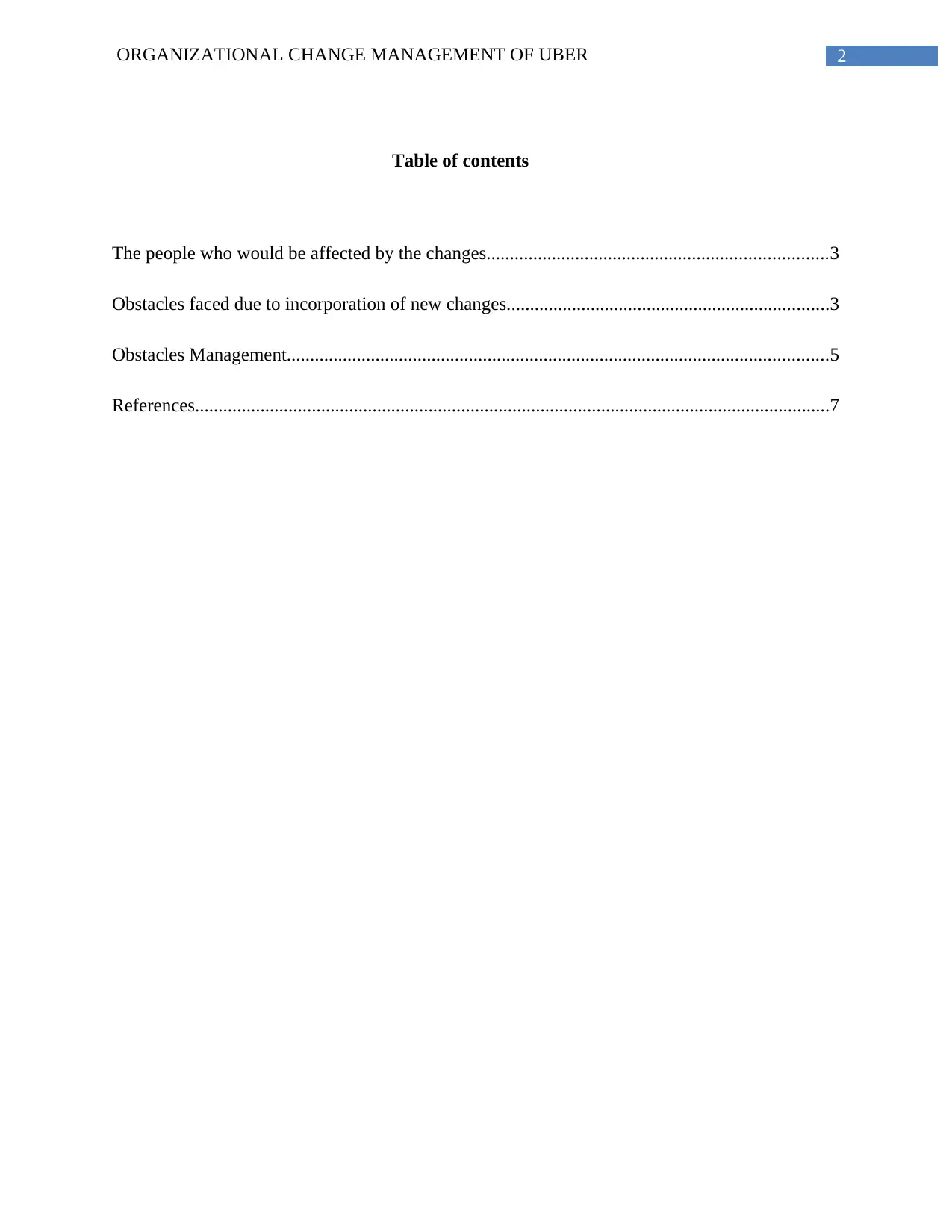
2ORGANIZATIONAL CHANGE MANAGEMENT OF UBER
Table of contents
The people who would be affected by the changes.........................................................................3
Obstacles faced due to incorporation of new changes.....................................................................3
Obstacles Management....................................................................................................................5
References........................................................................................................................................7
Table of contents
The people who would be affected by the changes.........................................................................3
Obstacles faced due to incorporation of new changes.....................................................................3
Obstacles Management....................................................................................................................5
References........................................................................................................................................7
⊘ This is a preview!⊘
Do you want full access?
Subscribe today to unlock all pages.

Trusted by 1+ million students worldwide
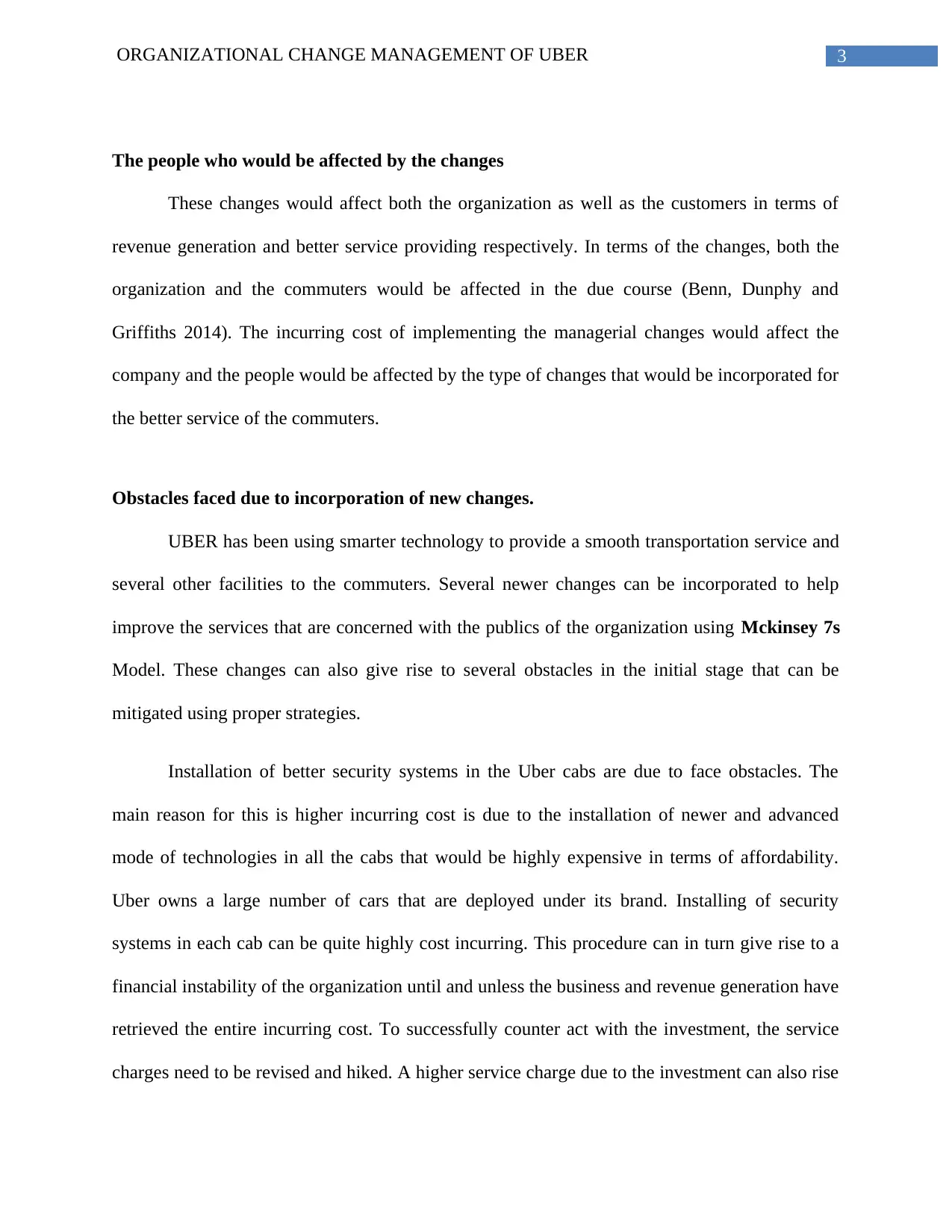
3ORGANIZATIONAL CHANGE MANAGEMENT OF UBER
The people who would be affected by the changes
These changes would affect both the organization as well as the customers in terms of
revenue generation and better service providing respectively. In terms of the changes, both the
organization and the commuters would be affected in the due course (Benn, Dunphy and
Griffiths 2014). The incurring cost of implementing the managerial changes would affect the
company and the people would be affected by the type of changes that would be incorporated for
the better service of the commuters.
Obstacles faced due to incorporation of new changes.
UBER has been using smarter technology to provide a smooth transportation service and
several other facilities to the commuters. Several newer changes can be incorporated to help
improve the services that are concerned with the publics of the organization using Mckinsey 7s
Model. These changes can also give rise to several obstacles in the initial stage that can be
mitigated using proper strategies.
Installation of better security systems in the Uber cabs are due to face obstacles. The
main reason for this is higher incurring cost is due to the installation of newer and advanced
mode of technologies in all the cabs that would be highly expensive in terms of affordability.
Uber owns a large number of cars that are deployed under its brand. Installing of security
systems in each cab can be quite highly cost incurring. This procedure can in turn give rise to a
financial instability of the organization until and unless the business and revenue generation have
retrieved the entire incurring cost. To successfully counter act with the investment, the service
charges need to be revised and hiked. A higher service charge due to the investment can also rise
The people who would be affected by the changes
These changes would affect both the organization as well as the customers in terms of
revenue generation and better service providing respectively. In terms of the changes, both the
organization and the commuters would be affected in the due course (Benn, Dunphy and
Griffiths 2014). The incurring cost of implementing the managerial changes would affect the
company and the people would be affected by the type of changes that would be incorporated for
the better service of the commuters.
Obstacles faced due to incorporation of new changes.
UBER has been using smarter technology to provide a smooth transportation service and
several other facilities to the commuters. Several newer changes can be incorporated to help
improve the services that are concerned with the publics of the organization using Mckinsey 7s
Model. These changes can also give rise to several obstacles in the initial stage that can be
mitigated using proper strategies.
Installation of better security systems in the Uber cabs are due to face obstacles. The
main reason for this is higher incurring cost is due to the installation of newer and advanced
mode of technologies in all the cabs that would be highly expensive in terms of affordability.
Uber owns a large number of cars that are deployed under its brand. Installing of security
systems in each cab can be quite highly cost incurring. This procedure can in turn give rise to a
financial instability of the organization until and unless the business and revenue generation have
retrieved the entire incurring cost. To successfully counter act with the investment, the service
charges need to be revised and hiked. A higher service charge due to the investment can also rise
Paraphrase This Document
Need a fresh take? Get an instant paraphrase of this document with our AI Paraphraser
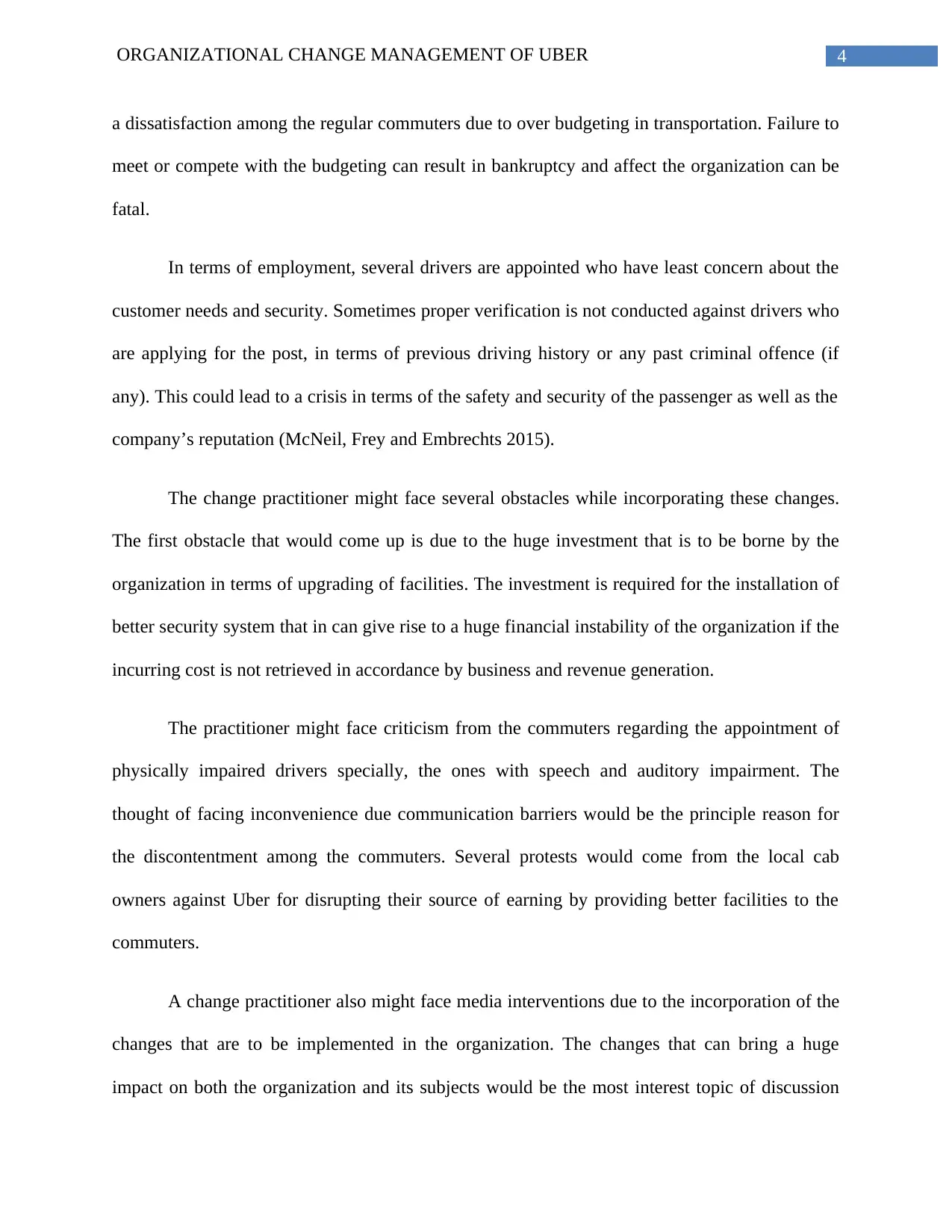
4ORGANIZATIONAL CHANGE MANAGEMENT OF UBER
a dissatisfaction among the regular commuters due to over budgeting in transportation. Failure to
meet or compete with the budgeting can result in bankruptcy and affect the organization can be
fatal.
In terms of employment, several drivers are appointed who have least concern about the
customer needs and security. Sometimes proper verification is not conducted against drivers who
are applying for the post, in terms of previous driving history or any past criminal offence (if
any). This could lead to a crisis in terms of the safety and security of the passenger as well as the
company’s reputation (McNeil, Frey and Embrechts 2015).
The change practitioner might face several obstacles while incorporating these changes.
The first obstacle that would come up is due to the huge investment that is to be borne by the
organization in terms of upgrading of facilities. The investment is required for the installation of
better security system that in can give rise to a huge financial instability of the organization if the
incurring cost is not retrieved in accordance by business and revenue generation.
The practitioner might face criticism from the commuters regarding the appointment of
physically impaired drivers specially, the ones with speech and auditory impairment. The
thought of facing inconvenience due communication barriers would be the principle reason for
the discontentment among the commuters. Several protests would come from the local cab
owners against Uber for disrupting their source of earning by providing better facilities to the
commuters.
A change practitioner also might face media interventions due to the incorporation of the
changes that are to be implemented in the organization. The changes that can bring a huge
impact on both the organization and its subjects would be the most interest topic of discussion
a dissatisfaction among the regular commuters due to over budgeting in transportation. Failure to
meet or compete with the budgeting can result in bankruptcy and affect the organization can be
fatal.
In terms of employment, several drivers are appointed who have least concern about the
customer needs and security. Sometimes proper verification is not conducted against drivers who
are applying for the post, in terms of previous driving history or any past criminal offence (if
any). This could lead to a crisis in terms of the safety and security of the passenger as well as the
company’s reputation (McNeil, Frey and Embrechts 2015).
The change practitioner might face several obstacles while incorporating these changes.
The first obstacle that would come up is due to the huge investment that is to be borne by the
organization in terms of upgrading of facilities. The investment is required for the installation of
better security system that in can give rise to a huge financial instability of the organization if the
incurring cost is not retrieved in accordance by business and revenue generation.
The practitioner might face criticism from the commuters regarding the appointment of
physically impaired drivers specially, the ones with speech and auditory impairment. The
thought of facing inconvenience due communication barriers would be the principle reason for
the discontentment among the commuters. Several protests would come from the local cab
owners against Uber for disrupting their source of earning by providing better facilities to the
commuters.
A change practitioner also might face media interventions due to the incorporation of the
changes that are to be implemented in the organization. The changes that can bring a huge
impact on both the organization and its subjects would be the most interest topic of discussion
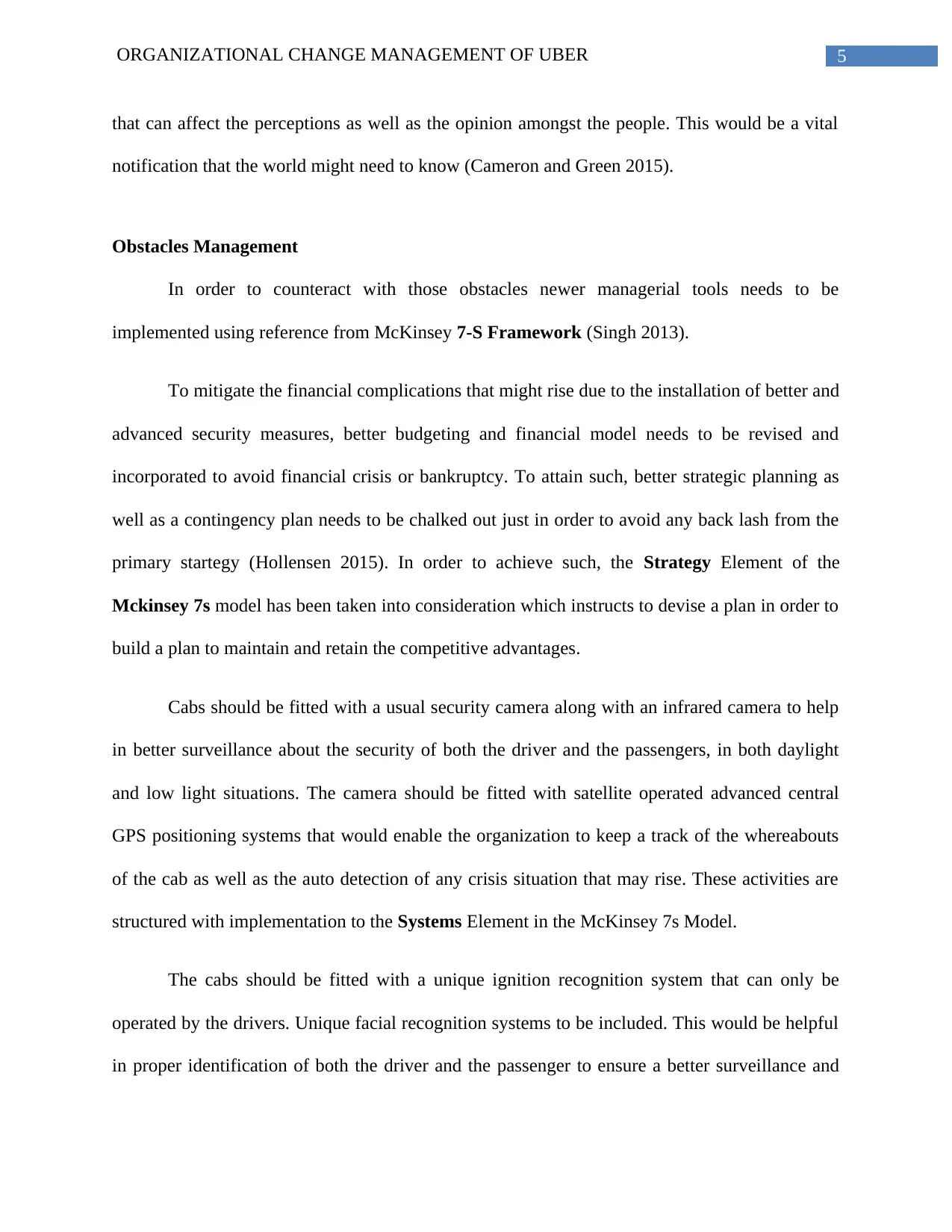
5ORGANIZATIONAL CHANGE MANAGEMENT OF UBER
that can affect the perceptions as well as the opinion amongst the people. This would be a vital
notification that the world might need to know (Cameron and Green 2015).
Obstacles Management
In order to counteract with those obstacles newer managerial tools needs to be
implemented using reference from McKinsey 7-S Framework (Singh 2013).
To mitigate the financial complications that might rise due to the installation of better and
advanced security measures, better budgeting and financial model needs to be revised and
incorporated to avoid financial crisis or bankruptcy. To attain such, better strategic planning as
well as a contingency plan needs to be chalked out just in order to avoid any back lash from the
primary startegy (Hollensen 2015). In order to achieve such, the Strategy Element of the
Mckinsey 7s model has been taken into consideration which instructs to devise a plan in order to
build a plan to maintain and retain the competitive advantages.
Cabs should be fitted with a usual security camera along with an infrared camera to help
in better surveillance about the security of both the driver and the passengers, in both daylight
and low light situations. The camera should be fitted with satellite operated advanced central
GPS positioning systems that would enable the organization to keep a track of the whereabouts
of the cab as well as the auto detection of any crisis situation that may rise. These activities are
structured with implementation to the Systems Element in the McKinsey 7s Model.
The cabs should be fitted with a unique ignition recognition system that can only be
operated by the drivers. Unique facial recognition systems to be included. This would be helpful
in proper identification of both the driver and the passenger to ensure a better surveillance and
that can affect the perceptions as well as the opinion amongst the people. This would be a vital
notification that the world might need to know (Cameron and Green 2015).
Obstacles Management
In order to counteract with those obstacles newer managerial tools needs to be
implemented using reference from McKinsey 7-S Framework (Singh 2013).
To mitigate the financial complications that might rise due to the installation of better and
advanced security measures, better budgeting and financial model needs to be revised and
incorporated to avoid financial crisis or bankruptcy. To attain such, better strategic planning as
well as a contingency plan needs to be chalked out just in order to avoid any back lash from the
primary startegy (Hollensen 2015). In order to achieve such, the Strategy Element of the
Mckinsey 7s model has been taken into consideration which instructs to devise a plan in order to
build a plan to maintain and retain the competitive advantages.
Cabs should be fitted with a usual security camera along with an infrared camera to help
in better surveillance about the security of both the driver and the passengers, in both daylight
and low light situations. The camera should be fitted with satellite operated advanced central
GPS positioning systems that would enable the organization to keep a track of the whereabouts
of the cab as well as the auto detection of any crisis situation that may rise. These activities are
structured with implementation to the Systems Element in the McKinsey 7s Model.
The cabs should be fitted with a unique ignition recognition system that can only be
operated by the drivers. Unique facial recognition systems to be included. This would be helpful
in proper identification of both the driver and the passenger to ensure a better surveillance and
⊘ This is a preview!⊘
Do you want full access?
Subscribe today to unlock all pages.

Trusted by 1+ million students worldwide
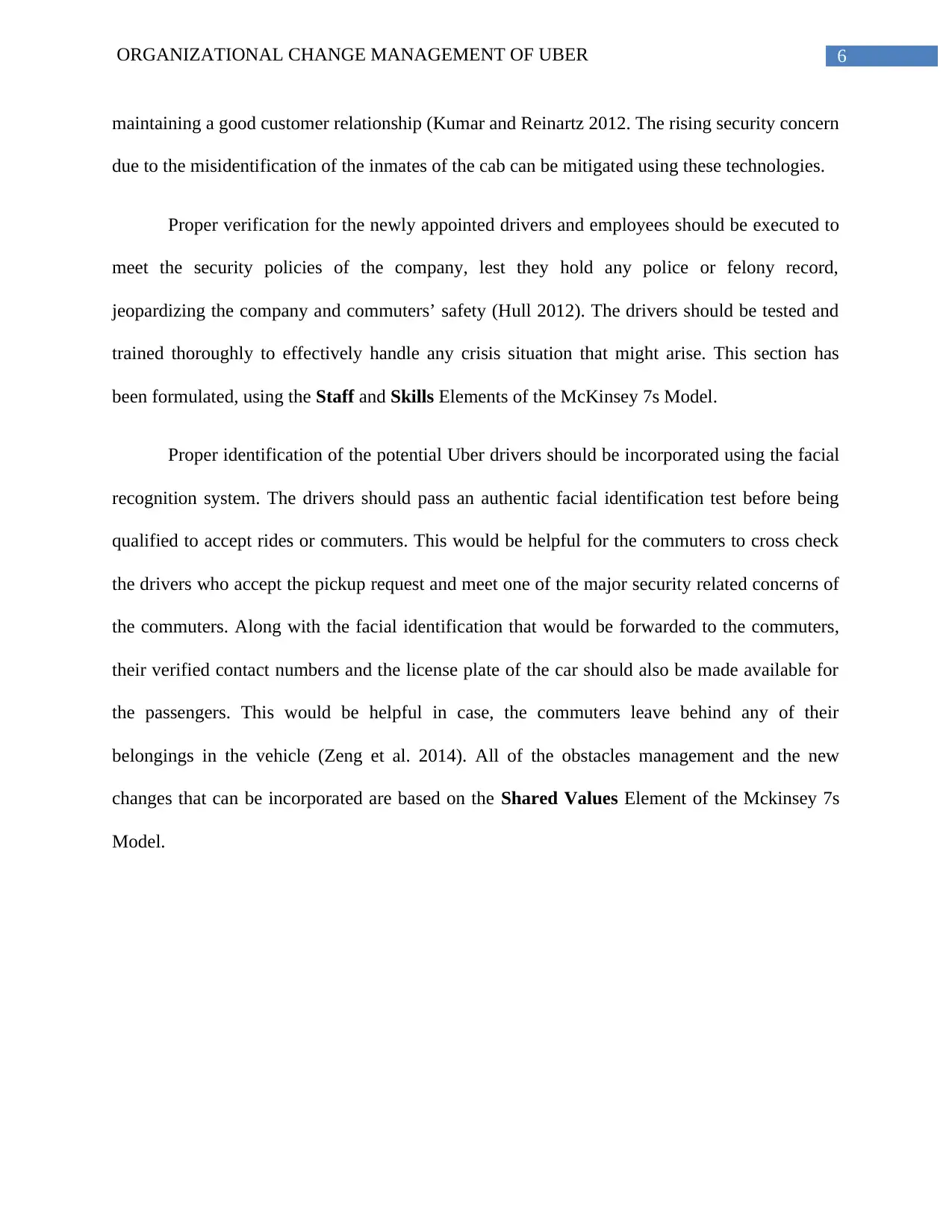
6ORGANIZATIONAL CHANGE MANAGEMENT OF UBER
maintaining a good customer relationship (Kumar and Reinartz 2012. The rising security concern
due to the misidentification of the inmates of the cab can be mitigated using these technologies.
Proper verification for the newly appointed drivers and employees should be executed to
meet the security policies of the company, lest they hold any police or felony record,
jeopardizing the company and commuters’ safety (Hull 2012). The drivers should be tested and
trained thoroughly to effectively handle any crisis situation that might arise. This section has
been formulated, using the Staff and Skills Elements of the McKinsey 7s Model.
Proper identification of the potential Uber drivers should be incorporated using the facial
recognition system. The drivers should pass an authentic facial identification test before being
qualified to accept rides or commuters. This would be helpful for the commuters to cross check
the drivers who accept the pickup request and meet one of the major security related concerns of
the commuters. Along with the facial identification that would be forwarded to the commuters,
their verified contact numbers and the license plate of the car should also be made available for
the passengers. This would be helpful in case, the commuters leave behind any of their
belongings in the vehicle (Zeng et al. 2014). All of the obstacles management and the new
changes that can be incorporated are based on the Shared Values Element of the Mckinsey 7s
Model.
maintaining a good customer relationship (Kumar and Reinartz 2012. The rising security concern
due to the misidentification of the inmates of the cab can be mitigated using these technologies.
Proper verification for the newly appointed drivers and employees should be executed to
meet the security policies of the company, lest they hold any police or felony record,
jeopardizing the company and commuters’ safety (Hull 2012). The drivers should be tested and
trained thoroughly to effectively handle any crisis situation that might arise. This section has
been formulated, using the Staff and Skills Elements of the McKinsey 7s Model.
Proper identification of the potential Uber drivers should be incorporated using the facial
recognition system. The drivers should pass an authentic facial identification test before being
qualified to accept rides or commuters. This would be helpful for the commuters to cross check
the drivers who accept the pickup request and meet one of the major security related concerns of
the commuters. Along with the facial identification that would be forwarded to the commuters,
their verified contact numbers and the license plate of the car should also be made available for
the passengers. This would be helpful in case, the commuters leave behind any of their
belongings in the vehicle (Zeng et al. 2014). All of the obstacles management and the new
changes that can be incorporated are based on the Shared Values Element of the Mckinsey 7s
Model.
Paraphrase This Document
Need a fresh take? Get an instant paraphrase of this document with our AI Paraphraser
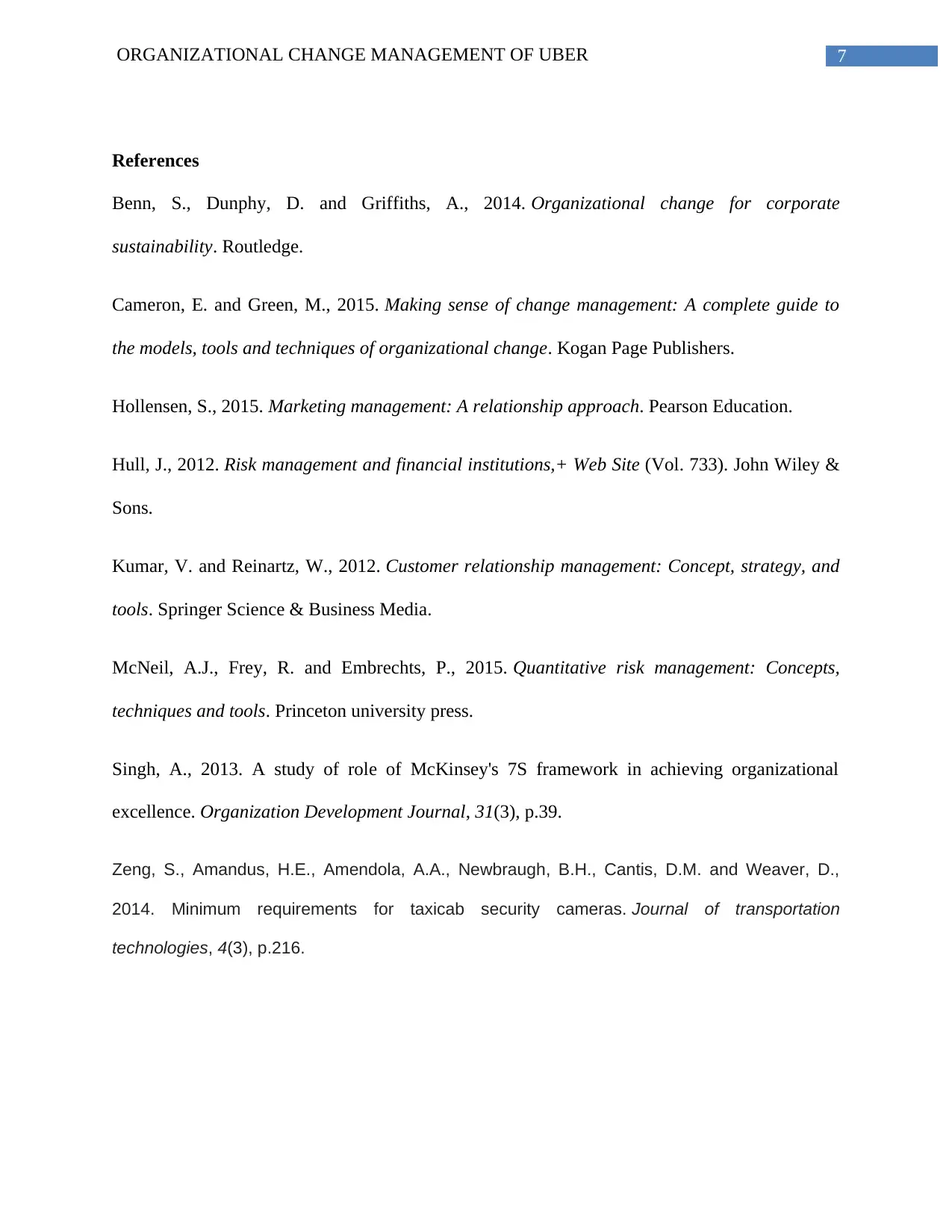
7ORGANIZATIONAL CHANGE MANAGEMENT OF UBER
References
Benn, S., Dunphy, D. and Griffiths, A., 2014. Organizational change for corporate
sustainability. Routledge.
Cameron, E. and Green, M., 2015. Making sense of change management: A complete guide to
the models, tools and techniques of organizational change. Kogan Page Publishers.
Hollensen, S., 2015. Marketing management: A relationship approach. Pearson Education.
Hull, J., 2012. Risk management and financial institutions,+ Web Site (Vol. 733). John Wiley &
Sons.
Kumar, V. and Reinartz, W., 2012. Customer relationship management: Concept, strategy, and
tools. Springer Science & Business Media.
McNeil, A.J., Frey, R. and Embrechts, P., 2015. Quantitative risk management: Concepts,
techniques and tools. Princeton university press.
Singh, A., 2013. A study of role of McKinsey's 7S framework in achieving organizational
excellence. Organization Development Journal, 31(3), p.39.
Zeng, S., Amandus, H.E., Amendola, A.A., Newbraugh, B.H., Cantis, D.M. and Weaver, D.,
2014. Minimum requirements for taxicab security cameras. Journal of transportation
technologies, 4(3), p.216.
References
Benn, S., Dunphy, D. and Griffiths, A., 2014. Organizational change for corporate
sustainability. Routledge.
Cameron, E. and Green, M., 2015. Making sense of change management: A complete guide to
the models, tools and techniques of organizational change. Kogan Page Publishers.
Hollensen, S., 2015. Marketing management: A relationship approach. Pearson Education.
Hull, J., 2012. Risk management and financial institutions,+ Web Site (Vol. 733). John Wiley &
Sons.
Kumar, V. and Reinartz, W., 2012. Customer relationship management: Concept, strategy, and
tools. Springer Science & Business Media.
McNeil, A.J., Frey, R. and Embrechts, P., 2015. Quantitative risk management: Concepts,
techniques and tools. Princeton university press.
Singh, A., 2013. A study of role of McKinsey's 7S framework in achieving organizational
excellence. Organization Development Journal, 31(3), p.39.
Zeng, S., Amandus, H.E., Amendola, A.A., Newbraugh, B.H., Cantis, D.M. and Weaver, D.,
2014. Minimum requirements for taxicab security cameras. Journal of transportation
technologies, 4(3), p.216.
1 out of 8
Related Documents
Your All-in-One AI-Powered Toolkit for Academic Success.
+13062052269
info@desklib.com
Available 24*7 on WhatsApp / Email
![[object Object]](/_next/static/media/star-bottom.7253800d.svg)
Unlock your academic potential
Copyright © 2020–2025 A2Z Services. All Rights Reserved. Developed and managed by ZUCOL.


